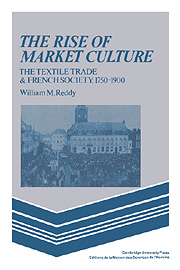Part Two - Uses of the market idea, 1816–1851
Published online by Cambridge University Press: 30 September 2009
Summary
Our relations with them [our employers] are a sort of market which is imposed on us by force, by violence, because we are compelled to work; this market enriches those who do nothing and allows those who work to want for everything. Were it voluntarily contracted by us, if there were any mutual obligation involved, it is we who would be the object [of enrichment] on the part of the idle.
Charles Noiret, Aux travailleurs (1840)By comparison with the ups and downs of commerce under the Empire, the business cycle during the Restoration and July Monarchy was orderly. The lows were not necessarily more shallow nor the highs less steep (although often they were), but the causes of these alterations were identifiable and, to a certain extent, systematic. War was replaced by poor harvests and bank failures as the triggers of periodic slumps. Price formation was erratic and unpredictable, but it did occur. Producers could use price information as a guide to planning over longer terms and thus could find profit in exploiting smaller price differentials. Speculation plagued the international supply lines for raw cotton and wool, occasionally creating purely artificial scarcities that defied all planning efforts, but in the intervals, supply was very steady and abundant, better than it had ever been in the eighteenth century, in fact. Yarn markets were more regular still. Trade in finished cloth became highly organized although prices remained erratic due to a new factor promoted by the merchants themselves: the increased pace of change in fashion.
- Type
- Chapter
- Information
- The Rise of Market CultureThe Textile Trade and French Society, 1750–1900, pp. 87 - 88Publisher: Cambridge University PressPrint publication year: 1984



